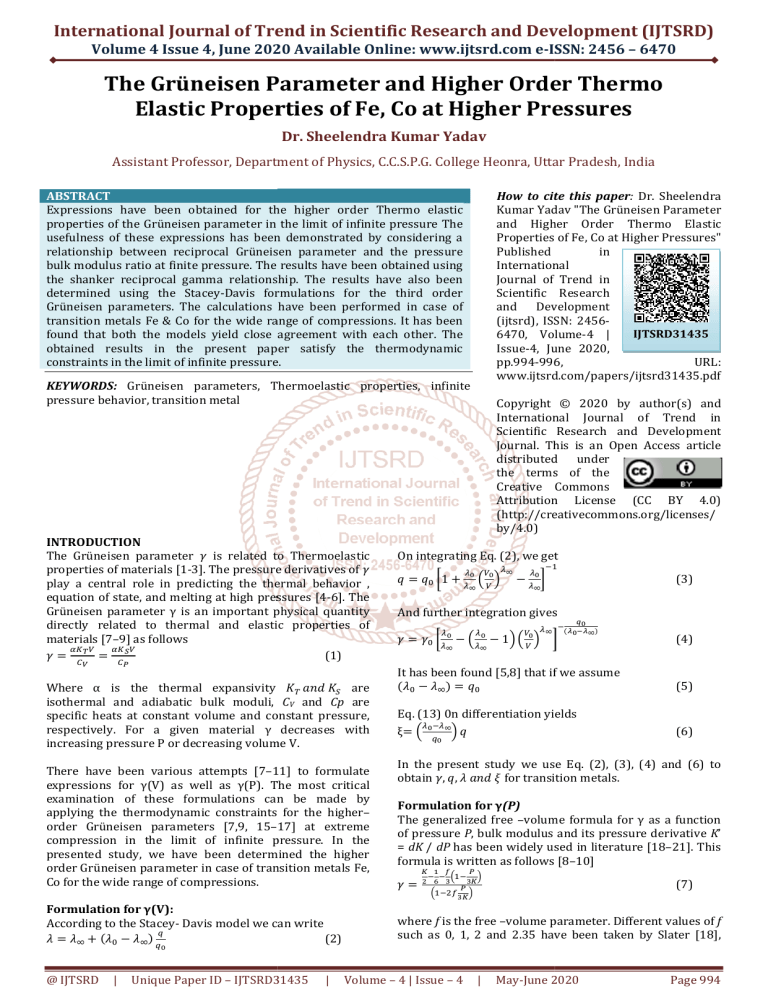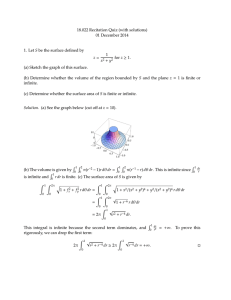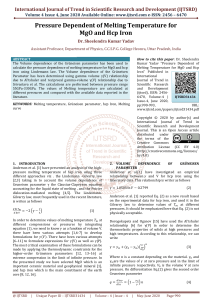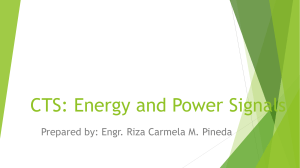
International Journal of Trend in Scientific Research and Development (IJTSRD)
Volume 4 Issue 4, June 2020 Available Online: www.ijtsrd.com e-ISSN:
ISSN: 2456 – 6470
The Grüneisen Parameter and
nd Higher Order Thermo
Elastic Properties of Fe, Co att Higher Pressures
Dr. Sheelendra Kumar Yadav
Assistant Professor, Department of Physics, C.C.S.P.G. College Heonra, Uttar Pradesh,
Pradesh India
ABSTRACT
Expressions have been obtained for the higher order Thermo elastic
properties of the Grüneisen parameter in the limit of infinite pressure The
usefulness of these expressions has been demonstrated by considering a
relationship between reciprocal Grüneisen parameter and the pressure
bulk modulus ratio at finite pressure. The results have been obtained using
the shanker reciprocal gamma relationship. The results have also been
determined using the Stacey-Davis
Davis formulations for the third order
Grüneisen parameters.
ters. The calculations have been performed in case of
transition metals Fe & Co for the wide range of compressions. It has been
found that both the models yield close agreement with each other. The
obtained results in the present paper satisfy the thermody
thermodynamic
constraints in the limit of infinite pressure.
How to cite this paper:
paper Dr. Sheelendra
Kumar Yadav "The Grüneisen Parameter
and Higher Order Thermo Elastic
Properties of Fe, Co at Higher Pressures"
Published
in
International
Journal of Trend in
Scientific Research
and Development
(ijtsrd), ISSN: 24562456
IJTSRD31435
6470, Volume-4
Volume
|
Issue-4,
4, June 2020,
pp.994-996,
996,
URL:
www.ijtsrd.com/papers/ijtsrd31435.pdf
KEYWORDS: Grüneisen parameters, Thermoelastic properties, infinite
pressure behavior, transition metal
INTRODUCTION
The Grüneisen parameter 𝛾 is related to Thermoelastic
properties of materials [1-3].
3]. The pressure derivatives of 𝛾
play a central role in predicting the thermal behavior ,
equation of state, and melting at high pressures [4
[4-6]. The
Grüneisen parameter γ is an important physical quantity
directly related to thermal and elastic properties of
materials [7–9] as follows
𝛾=
=
(1)
Where α is the thermal
mal expansivity 𝐾 𝑎𝑛𝑑 𝐾 are
isothermal and adiabatic bulk moduli, CV and Cp are
specific heats at constant volume and constant pressure,
respectively. For a given material γ decreases with
increasing pressure P or decreasing volume V.
There have been various attempts [7–11]
11] to formulate
expressions for γ(V) as well as γ(P).
(P). The most critical
examination of these formulations can be made by
applying the thermodynamic constraints for the higher
higher–
order Grüneisen parameters [7,9, 15–17]
17] at extreme
compression in the limit of infinite pressure. In the
presented study, we have been determined the higher
order Grüneisen parameter in case of transition metals Fe,
Co for the wide range of compressions.
Formulation for γ(V):
According to the Stacey- Davis model we can write
𝜆 = 𝜆∞ + (𝜆 − 𝜆∞ )
(2)
@ IJTSRD
|
Unique Paper ID – IJTSRD31
31435
|
Copyright © 2020
20
by author(s) and
International Journal of Trend in
Scientific Research and Development
Journal. This is an Open Access article
distributed under
the terms of the
Creative Commons
Attribution License (CC BY 4.0)
(http://creativecommons.org/licenses/
by/4.0)
On integrating Eq. (2), we get
𝑞 =𝑞 1+
∞
∞
−
(3)
∞
And further integration gives
𝛾=𝛾
∞
−
∞
−1
∞
(
∞)
(4)
It has been found [5,8]] that if we assume
(𝜆 − 𝜆∞ ) = 𝑞
(5)
Eq. (13) 0n differentiation yields
∞
ξ=
𝑞
(6)
In the present study we use Eq. (2), (3), (4) and (6) to
obtain 𝛾, 𝑞, 𝜆 𝑎𝑛𝑑 𝜉 for transition metals.
Formulation for γ(P)
The generalized free –volume
volume formula for γ as a function
of pressure P,, bulk modulus and its pressure derivative K’
= dK / dP has been widely used in literature [18–21].
[18
This
formula is written as follows [8–10]
[8
(7)
𝛾=
where f is the free –volume
volume parameter. Different values of f
such as 0, 1, 2 and 2.35 have been taken by Slater [18],
Volume – 4 | Issue – 4
|
May-June 2020
Page 994
International Journal of Trend in Scientific Research and Development (IJTSRD) @ www.ijtsrd.com eISSN: 2456-6470
Dugdale and MacDonald [19], Volume dependence of
Grüneisen parameter 199
Where y is a function of x such that y remains positive
finite at x→ 0
Vashchenko and Zubarev [20], and by Barton and Stacey
[21]. The main difficulty associated with Eq. (7) is
regarding the uncertainties in the value of f arising from
various approximations involved in the derivation of the
formula [9]. It is even more uncertain to use Eq. (7) for
evaluating derivatives of γ because of difficulties in
determining df / dP and d2 f / dP2 . Such calculations are
tedious at finite pressures. However, it should be
indicating that Eq. (7) in the limit of infinite pressure gives
expressions [9, 15] which are free from the free –volume
parameter f. An alternative formulation for _(P) has been
presented by Shankar et al. [17]. They proposed the
following relationship
if y becomes zero at x→ 0
( ⁄ )
=0
+ 𝐾∞∙
=
∞
(8)
−
Where 𝐾∞ is the minimum value of 𝐾 ∙ in the limit of infinite
pressure. Eq. (8) satisfies the following identity [20, 3]
=
(9)
∞
∞
Eq. (8) yields the following expressions for the higher
order derivatives of the Grüneisen parameter [16]
= 𝐾∞∙
−
1 − 𝐾∙
(10)
∞
ξ= −
(11)
+ 𝐾∙ + 𝑞
∙ / )
∙
λ(
∙ / )
−
( ∙
/ )
∙ / )
λ(
∙
−
λ(
∙ / )
+𝑞
(12)
It should be mentioned that the expressions for γ, q, λ and
ξ given above satisfy the boundary conditions in the limit
of infinite pressure viz. 𝛾∞ and 𝜆∞ both remain positive
finite whereas q∞ and x∞ both tend to zero. Equations (8),
(10), (11) and (12) at infinite pressure become identical to
the corresponding expressions derived from the basic
principles of calculus which have the status of identities
[13, 14, 16].
INFINITE PRESSURE BEHAVIOUR
P is a function of V such that increases continuously with
the decreasing V. At extreme compression (𝑉 → 0), P
becomes infinitely large, then we can write
→
= 𝑛𝑒𝑔𝑎𝑡𝑖𝑣𝑒 𝑓𝑖𝑛𝑖𝑡𝑒
(13)
Since
=−
(14)
Where K is bulk modulus
𝐾 = −𝑉
(15)
Eq. (13) and (14) yield
= 𝑝𝑜𝑠𝑖𝑡𝑖𝑣𝑒 𝑓𝑖𝑛𝑖𝑡𝑒
(16)
∞
Now taking 𝑦 =
in expression
@ IJTSRD
Because K/P is positive finite (Eq. 16), on solving Eq. (17),
we get
(1 − 𝐾 ∙ 𝑃 ⁄𝐾 )∞ = 0
(18)
Eq. (18) yields
𝐾∞∙ =
(19)
∞
Equation (19) has the status of an identity [7,5, 20]. In
view of Eq. (16), it is revealed from Eq. (19) that𝐾∞∙ , the
pressure derivative of bulk modulus, 𝑑𝐾 ⁄𝑑𝑃, at infinite
pressure remains positive finite.
Result and discussion
The quantities calculated as a function of pressure can be
converted to those as a function of volume. and vice versa
with the help of an equation of state theory. We use the
Stacey K- primed equation of state [9] which is based on
Eq.(9). And can be expressed as
∙
= + 1 − ∞∙
(20)
On integration, Eq. (20) gives
∙
λ= (
(17)
→
|
𝑎𝑛𝑑 𝑥 = 𝑉
→
∙⁄ ∙
∞
= 1 − 𝐾∞∙
(21)
Further integration of Eq. (21) gives
∙
∙
ln
= ∙ −1
+ , ln 1 − 𝐾∞∙
∞
(22)
∞
The Grüneisen parameter values 𝛾 and its higher order
derivatives 𝑞 𝜆 𝑎𝑛𝑑 𝜉 calculated from the Shanker
formulation [16] using Eq. (8), (10), (11) and (12). Values
of 𝛾 𝑞 𝜆 𝑎𝑛𝑑 𝜉 get decrease with the increment in value of
pressure. In the Stacey-Davis formulation they are
expressed as a function of 𝑉 ⁄𝑉 . At extreme compression,
V tends to zero, 𝑞∞ 𝑎𝑛𝑑 𝜉∞ both tends to zero, but
𝛾∞ 𝑎𝑛𝑑 𝜆∞ both remains positive finite.
Conclusion
The Grüneisen parameter at extreme compression, the
pressure for the earth inner core and outer core boundary,
the melting temperature for Fe and Co is very close. The
theory of materials at (∞) infinite pressure originally due
to Stacey [5,7] and further developed by Shanker et al
[12,13] has been extended in the present study. Values of
𝛾 𝑞 𝜆 𝑎𝑛𝑑 𝜉 at finite pressures for transition metals (Fe,
Co) and Calculated from the two formulations compare
with each other. Results are quite similar for different
transition metals (Fe, Co). Results can be produce using
the input parameter given in table first. It should be
emphasized that the pressure derivative of bulk modulus
play the central role in determining Thermoelastic
properties and equation of state of materials [1,3,21-23].
We thus obtain the following generalized expression for
the higher pressure derivative of bulk modulus at infinite
pressure.
=0
Unique Paper ID – IJTSRD31435
|
Volume – 4 | Issue – 4
|
May-June 2020
Page 995
International Journal of Trend in Scientific Research and Development (IJTSRD) @ www.ijtsrd.com eISSN: 2456-6470
Element
Fe(bcc)
Co(fcc)
Table (1) Values of input parameters for NaCl
𝜸𝟎
𝑲𝟎
𝑲∙𝟎 𝑲∙
𝜸
𝒒𝟎
𝝀𝟎
Z
26 1.83 187.6 5.8 3.48 1.33 1.13 6.13
27 1.77 216.5 4.7 2.82 1.24 1.21 5.91
𝝃𝟎
4.39
4.20
35
30
25
20
T=300K
T=450K
15
T=600K
10
5
0
0.642672 0.653109 0.670312 0.696217 0.720577 0.743547 0.765259 0.785822 0.805329
Plots between pressure P and compression V/V0 for Fe & Co at different temperatures
Acknowledgments
We are thankful to the reviewers for their helpful
comments. Thanks are also due to Professor Anuj Vijay &
Professor J. Shanker, for some very useful discussions.
[13]
Shanker J., Sunil K. and Sharma B. S., Physica B
407, (2012) 2083.
[14]
Shanker J., Sunil K. and Sharma B. S., Phys. Earth
Planet. Inter. 262, (2017) 41.
References
[1]
O. L. Anderson, Equation of state of solids for
Geophysics and Ceramic Science, Oxford
University Press, New York. 1995.
[15]
Shanker J., Singh B. P. and Srivastava S. K., Phys.
Earth Planet. Inter. 147, (2004) 333.
[16]
Slater J. C., Introduction to Chemical Physics (New
Yark, Mc Graw Hill,1939).
[2]
M. A. Barton and F. D. Stacey, Phys. Earth Planet.
Inter. 39 (1985)167.
[17]
[3]
F. D. Stacey, Phys. Earth Planet Inter.89 (1995)
219.
Dugdale J. S. and MacDonald D. K. C., Phys. Rev. 89,
(1953) 832.
[18]
[4]
S. S. Kushwah, A. K. Upadhayay and M. P. Sharma,
High Temp.-High Press.44, (2015)59.
Vashchenka V. Ya. and Zubarev V. N., Sov. Phys.
Solid State 5, (1963) 653.
[19]
[5]
F. D. Stacey Rep. Prog. Phys. 68, (2005) 341.
Barton M. A. and Stacey F. D., Phys. Earth Planet.
Inter. 39, (1985) 167.
[6]
A. Vijay, High Temp.-High Press. 43, (2014)47
[20]
Knopoff L., J. Geophys. Res. 68, (1963) 350.
[7]
Stacey F. D., Davis P. M., Phys. Earth Planet. Inter.
142, (2004) 137
[21]
S. K. Sharma and B.K. Sharma Physica B405
(2010)3145.
[8]
At’shuler L. V., Brusnikin S. E. and Kuz’menkov E.
A., J. Appl. Mech. Tech. Phys. 28, (1987) 129
[22]
S. S. Kushwah, and N. K. Bhardwaj, Int.J. Mod.
Phys. B, 24, 1187(2010).
[9]
Shanker J., Singh B. P. and Baghel H. K., Physica B
387, (2007) 409.
[23]
S. Kumar, S. K. Sharma, and O. P. Pandey, High
Tempe- High Press. 44(2015)339.
[10]
Srivastava S. K., Sol. State Communi. 151, (2011)
1472.
[24]
K. Sheelendra & A. Vijay, Journal of Physics and
Chemistry of Solids. 123 (2018) 364-370.
[11]
Kushwah S. S., Tomar Y. S. and Upadhyay A. K., J.
Phys. Chem. Sol. 74, (2013) 1143.
[25]
K. Sheelendra & A. Vijay, High Temperatures-High
Pressures, Vol. 47, pp. 193–204.
[12]
Shanker J., Dulari P. and Singh P. K., Physica B 404,
(2009) 4083.
[26]
K. Sheelendra & A. Vijay, 9th National Conference
on Thermophysical Properties (NCTP-2017)
030001-1–030001-5.
@ IJTSRD
|
Unique Paper ID – IJTSRD31435
|
Volume – 4 | Issue – 4
|
May-June 2020
Page 996




